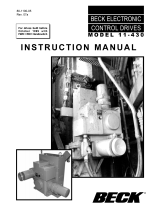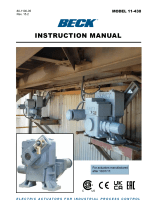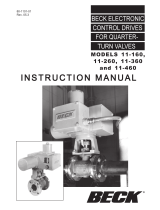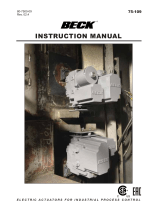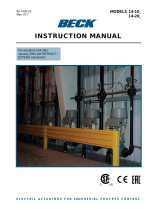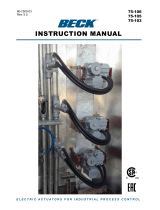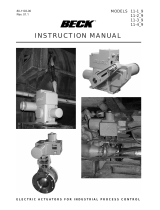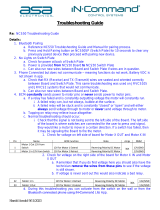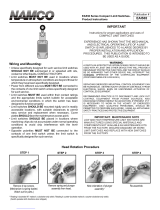
80-1100-05
Rev. 14.9
INSTRUCTION MANUAL
MODEL 11-430
R
ELECTRIC ACTUATORS FOR INDUSTRIAL PROCESS CONTROL
For actuators manufactured
after 10/01/17.

80-1100-05, Rev. 14.9
2
This manual contains the information needed
to install, operate, and maintain the Beck 11-430
Electronic Actuator, manufactured by Harold
Beck & Sons, Inc.
NOTICE: This manual includes information that
free. Please read and understand the appropriate
The 11-430 is a high torque electric actuator
designed to provide precise position control of
multiple burner tilt arrays, dampers, and other
devices requiring up to 5,200 lb-ft (7 046 N•m) of
actuator torque. The 11-430 consists of a Beck
11-400 actuator connected to a large gear
reduction unit that increases the output torque of
the 11-400 by a factor of 3:1.
INTRODUCTION

80-1100-05, Rev. 14.9
3
Introduction ...................................................................................................................... 2
Product Description ........................................................................................................
....................................................................................................6
...........................................................................................8
Control Options .............................................................................................................
Installation ...................................................................................................................... 11
Input Signal Wiring ...................................................................................................... 13
Feedback Signal Wiring ..............................................................................................16
Wiring Options.............................................................................................................18
Start-up .......................................................................................................................20
Operation ........................................................................................................................ 22
......................................................................................................................26
Switches ......................................................................................................................26
Direction Change ........................................................................................................28
Feedback Signal .........................................................................................................30
Demand Signal............................................................................................................34
Maintenance ...................................................................................................................
Routine ........................................................................................................................38
Component Replacement ...........................................................................................39
Troubleshooting ..........................................................................................................43
Appendix ........................................................................................................................
Spare Parts .................................................................................................................45
Control Assembly ........................................................................................................46
CPS-5 Data .................................................................................................................47
CPS-5 Functional Block Diagram................................................................................48
Optional LED Display .................................................................................................. 49
Index ...............................................................................................................................
Services ..........................................................................................................................
TABLE OF CONTENTS

80-1100-05, Rev. 14.9
4
The Beck 11-430 actuator is engineered
for precise, reliable operation of dampers and
multiple burner tilt arrays. The cool, stable
operation of Beck’s control motors coupled
with the powerful gear train provide the tight,
responsive control required by modern control
loops to optimize output while keeping operating
costs low.
The unique all spur gear construction
used in the Beck Actuator is designed for long
term durability. The gear train can withstand
accidental stalls of up to four days without failure,
and will resume instant response immediately
upon removal of the condition (see page 24 for
Stall Protection information). Mechanical stops
in the gear train prevent over-travel.
An easy-to-turn, spoke-free Handwheel is
in corporated into the 11-430 design to allow
manual operation during installation or power
outages. The Handwheel can be used to move
a driven shaft to any position smoothly and easily
under full load conditions.
The driven shaft may also be operated at
its individual location by utilizing the actuator's
built-in electric Handswitch.
The heavy-duty crank arm of the 11-430
actuator can be eld‑adjusted to travel anywhere
in the 360° range.
Beck’s ESR-5 Electronic Signal Receiver
provides precise actuator control from either
conven tional analog or computer based control
systems.
Beck’s CPS-5 Contactless Position Sensor
provides accurate position feedback in demand-
ing environmental conditions, with no contacting
or wiping surfaces to wear or intermittently lose
contact. The CPS‑5 provides innite resolution
with linearity error of less than ±1% of span over
the actuator’s full travel.
The Beck 11-430 electronic actuator is
designed with individual weatherproof enclosures
to protect the main components. The cutaway
illustration below shows the basic features of the
11-400 as well as their locations.
COMPONENT
LOCATIONS
PRODUCT DESCRIPTION
Electronic Signal
Receiver (ESR‑5)
Wiring Terminal
Block
Handswitch
Handwheel,
Motor Housing
and Gear Train
Travel Limit and
Auxiliary Switches
Contactless Posion
Sensor (CPS‑5)

80-1100-05, Rev. 14.9
5
BECK LINKAGE KITS
Beck pipe linkage kits are available for
completing the mechanical connection from the
actuator crank arm to the load. Through the use
of standardized selection, the linkage can be
ordered even if the exact length is not determined
until the actuator and driven device are installed.
All Beck 11-430 actuators are furnished with
a crank arm and rod end (see pages 8, 9, and 21
for dimensions). All rod ends furnished by Beck
incorporate bearings to accommodate some lat-
eral misalignment. Once the connection is made,
linkage kits can be adjusted ±1 1/2” (38 mm)
without removal of the crank arm or load lever,
making nal mechanical calibration simple.
See page 20 for linkage requirements.

80-1100-05, Rev. 14.9
6
Operating Conditions -40 to 185°F. (-40 to 85°C.)
0 to 100% relative humidity, non-condensing
Demand Signal Options, with 0–5 mA 10–50 mA
Electronic Signal Receiver 1–5 mA 1–5 V dc
(ESR-5) 4–20 mA -10–10 V dc
Input Signal Span Adj. 50% to 400% of 4 V span (except ‑10–10 V dc)
Input Signal Zero Adj. ‑100 to 275% of span (except ‑10–10 V dc)
Deadband 0.6% of span (recommended deadband for most applications);
narrower and wider deadbands are available
Sensitivity 25% of deadband
Direct AC 120 V ac for 2-position, multi-position or modulating V ac control
Square Function Actuator output shaft moves proportionally to the square of the input signal
(Optional)
Feedback Signal Options, 1–5 mA 1–5 V dc
with Contactless Position 4–20 mA 0–16 V dc
Sensor (CPS-5) 10–50 mA -10–10 V dc
Output Stability 0.25% of span from 102 to 132 V ac
±0.03%/°C. of span for 0 to 50°C.
±0.05%/°C. of span for -40 to 85°C.
Linearity ±1% of span, max. independent error
Hysteresis 0.25% of span at any point
Isolation Max. leakage of 10 µA at 60 V rms, 60 Hz from output to ground
Film Potentiometer 1,000 ohms
Max. Voltage 40 V
Wattage 2 W max.
Linearity ±0.5%
Max. Wiper Current 1 mA
Action on Loss of Power Stays in place
Action on Loss of Input Stays in place or moves to full travel or zero position. Drives to any preset
Signal (Power On) position with optional switch assembly on Models 11-437 and 11-438.
Field adjustable.
Actuator
Power
120 V ac, single-phase, 60 Hz (standard), 50 Hz (optional)
208, 240, 380, 415, 480 & 575 V ac, 50 or 60 Hz (optional)
Allowable Tolerance: +10%
- 15%
Model Power (VA)
11-430 400 3.1 1.8 1.6 .98 .89 .78 .65
GENERAL SPECIFICATIONS

80-1100-05, Rev. 14.9
7
Stall Protection and If the motor tries to run in one direction for more than 300 seconds, the
Annunciation (Optional) Stall Protection Module will shut o power to the motor and a relay contact
will change state. The relay is rated for 120 V ac or dc, 10 VA. For more
information, see Beck publication 80-0017-03.
Limit Switches Two SPDT, one for CW and one for CCW limit of travel (rated 6A, 120
V ac; .5A, 125 V dc; .25A, 250 V dc). Actuators having position sensing
capability (Options 5 thru 8), have over-travel limit switches set 1/2°
outside the CW and CCW travel range (typically, –0.5° and 100.5°).
Actuators without position sensing (Options 3 and 4), have end-of-travel
limit switches set at the CW and CCW travel range (typically, 0° and 100°).
Auxiliary Switches Up to four switches available (rated 6A, 120 V ac; .5A, 125 V dc; .25A,
250 V dc). Switches are labeled S1 to S4 and are cam‑operated, eld‑
adjustable. S1 and S4 are set to operate just before reaching CCW travel
limit. S2 and S3 are set to operate just before reaching CW travel limit.
Handswitch Permits local electrical operation, independent of controller signal.
Standard on all units. An auxiliary contact is available as an option for
remote auto indication (rated 2.5A, 120 V ac; 2.0A, 28 V dc).Handwheel
Provides manual operation without electrical power.
Motor 120 V ac, single-phase, no-burnout, non-coasting motor has instant
magnetic braking. Requires no contacts or moving parts. Can remain
stalled for approximately four days (cumulative) without damaging the gear
train.
Gear Train High‑eciency, precision‑cut, heat‑treated alloy steel and ductile iron spur
gears. Interchangeable gear modules permit eld change of timing.
Mechanical Stops Prevent over-travel during automatic or manual operation.
Enclosures
11-400 Drive Type 4X, precision-machined aluminum alloy castings painted with
corrosion-resistant polyurethane paint, provide a rugged, dust-tight,
weatherproof enclosure.
Gear Reduction Unit Precision-machined aluminum alloy casting painted with corrosion-
resistant polyurethane paint, provides a rugged, dust-tight, weatherproof
enclosure.
Standards** CSA Labeled (US & Canada); CE Compliant; UKCA Compliant
**NOTE: May not be available with all options and models. For more information, please call Beck at 215-968-4600.

80-1100-05, Rev. 14.9
8
ORIENTATION A
Front View Side View
18 15/16
[481]
10 1/8
[257]
8 13/16
[224]
2 63/64
[76]
3 1/2
[89] 3 1/2
[89]
28 13/32
[722]
7
[178]
5 3/8
[137]
19 1/32
[483]
1 1/2–12
UNF TH’D.
x 2 5/8 [67]
DEEP
90° ELBOW
1” N.P.T.
CONDUIT
POWER
CONNECTION
5
[127]
ALLOW
10” [254]
MIN. FOR
ACCESS
GEAR
MODULE
ASSEMBLY
6 13/64
[158]
6 1/16
[154]
11 7/16
[291]
12 7/8
[327]
10 1/8
[257]
10 13/16
[275]
11 9/16
[294]
1 19/32
[41]
4 21/32
[118] COVER, POSITION
SENSING DEVICES
2 3/16
[56]
2 5/8±1/8
[67±3]
9 3/16
[233]
1 9/16
[40]
1 1/2
[38]
11 7/8±3/8
[302±10]
7 1/8
[181]
7 19/32
[193]
10 1/4
[260]
10 1/64
[254] 4 3/4
[121]
17 13/32
[442]
24 39/64
[625]
ALLOW 4” [102] FOR REMOVAL
1” N.P.T.
CONDUIT
SIGNAL
CONNECTION
29 1/16 MAX.
[738]
ALLOW 9 “ [229]
FOR REMOVAL
1 1/8 [29] DIA.
(4) HOLES
RECOMMENDED SCREW TORQUES
Size Torque
in lb-ft N•m
Gear Reduction Unit
Crank Arm Clamp Screws (4) 3/4-16 420 569
Rod End Nut 3/4-16 200 271
Crank Pin Screws (3)
(14-8022-42 crank arm) 3/4-16 420 569
(14-8022-44 crank arm) 3/4-16 300 407
11-400 Actuator
Cover Screws 5/16-18 10 14
Motor Screws 3/8-16 16 22
Gear Module Screws 5/16-18 10 14
Adaptor Plate to Gear
Reduction Unit Screws (4) 1/2-13 45 61
BECK MODEL 11-430
Torque
lb-ft
(N•m)
Timing
(sec.)
Net
Wt.
lb (kg)
Output
Shaft Dia.
in (mm)
Max.
Overhung
Load
lb (kg)
5,200
(7 046)
108
790
(358)
3 15/16
(100)
20,000
(9 072)
180 Crank Arm
14-8022-42
OR
2,900
(3 929)
72 15,000
(6 804)
120 Crank Arm
14-8022-44
OUTLINE DIMENSION DRAWINGS

80-1100-05, Rev. 14.9
9
All Dimensions are in inches and [mm]
and are subject to change.
ORIENTATION B
Front View Side View
AVAILABLE CRANK ARMS (WITH ROD ENDS)
CRANK ARM
CLAMP SCREWS (4) 6.5"–10.5"
[165–266]
CRANK PIN
SCREWS (3)
ROD END NUT
AND
CRANK PIN
1 1/2-12 UNF x
2 5/8 DEEP
5 3/8
[136]
CRANK ARM
CLAMP SCREWS (4)
CRANK PIN SCREWS (3) ROD END NUT
AND
CRANK PIN
9”–15”
[228–381]
19
[482]
5 3/8
[136]
1 1/2-12 UNF x
2 5/8 DEEP
STANDARD CRANK ARM ALTERNATE CRANK ARM
ROD END DETAIL
18 15/16
[481]
10 1/8
[257]
8 13/16
[224]
3 1/2
[89]
3 1/2
[89]
2 63/64
[76]
28 13/32
[722]
19 1/32
[483]
7
[178]
GEAR
MODULE
ASSY.
7/8
[22]
10 1/8
[257]
11 9/16
[294]
11 7/16
[291]
12 7/8
[327]
21 5/8
[549]
ALLOW 9” [229] FOR REMOVAL
1 1/8 [29] DIA.
(4) HOLES
1” N.P.T. CONDUIT
POWER CONNECTION
4 21/32
[118]
ALLOW 10” [254]
MIN. FOR ACCESS
COVER,
TERMINAL BLOCK
EXTERNAL WIRING
1” N.P.T. CONDUIT
SIGNAL CONNECTION
24 1/8
[613]
21 3/4
[553]
2 3/16
[56]
2 5/8±1/8
[67±3]
9 3/16
[233]
1 9/16
[40]
1 1/2
[38]
11 7/8±3/8
[302±10]
7 1/8
[181]
10 1/4
[260]
10 1/64
[254]
17 13/32
[442]
24 39/64
[625]
4 3/4
[121]
Thread Size 1 1/2–12
Dim. "C" 1.312"
Dim. "D" 1.500"
Dim. "W" 2.000"
Angle Ø 6.5°

80-1100-05, Rev. 14.9
10
CONTROL OPTIONS
TABLE 1:
SUMMARY OF CONTROL OPTIONS
MODEL
NO.
CONTROL
TYPE
INPUT
SIGNAL FEEDBACK
DEVICE
EXTERNAL
OUTPUT
SIGNAL
AUXILIARY
SWITCH
OPTIONS
11-438 Electronic
Modulating
0–5 or
1–5 mA 13-2246-02
CPS-5
Contactless
Position
Sensor
(with
Monitor)
None
2
4
2+INTLOS
4–20 mA 20-4400-12
4–20 mA 13-2246-03
10–50 mA 13-2246-04 1–5 V dc
0–10 V dc 13-2246-07 16 V dc 20-4400-13
1–5 V dc 13-2246-05 50 mA max.
-10–10 V dc 13-2246-08
11-437 Electronic
Modulating
0–5 or
1–5 mA 13-2246-02
1000 ohm
Potentiometer
20-3060-03
None,
1000 ohm
Aux. Pot.
n/a
None
2
4
2+INTLOS
4–20 mA 13-2246-03
10–50 mA 13-2246-04
0–10 V dc 13-2246-07
1–5 V dc 13-2246-05
-10–10 V dc 13-2246-08
11-436
Direct
AC Control
(Modulating)
120 V ac None CPS-5
Contactless
Position
Sensor
(without
Monitor)
4–20 mA 20-4400-02
None
2
4
Low Power 13-2246-50
120 V ac (Relay Board) 1–5 V dc
Low Power 13-2246-51 16 V dc or 20-4400-03
dc (Relay Board) 50 mA max.
11-435
Direct
AC Control
(Modulating)
120 V ac None
1000 ohm
Potentiometer
20-3060-03
1000 ohm
Pot. n/a
None
2
4
Low Power
120 V ac
13-2246-50
(Relay Board)
Low Power
dc
13-2246-51
(Relay Board)
11-434
5 Position
120 V ac n/a None None n/a
None
4 Position
3 Position None
2
11-433 2 Position
Open/Close 120 V ac n/a None None n/a
None
2
4

80-1100-05, Rev. 14.9
11
SAFETY PRECAUTIONS
WARNINGWARNING
Installation and service instructions
in this manual. Please read
and understand the appropriate
drive.
STORAGE INFORMATION
The 11-430 should be stored in its shipping
crate in a clean, dry area where the temperature
is between -40° and 85°C (-40° to 185°F).
If it is necessary to store the actuator outdoors
for a long period of time, it should be stored above
ground and covered with a waterproof cover. Do
not stack 11-430 crates on top of one another.
Stored drives should be checked periodically to
make sure no condensation has formed in the
electronic and terminal compartments. Damage
due to moisture while in storage is not covered by
warranty.
UNPACKING
The actuator is shipped in a slatted wooden
crate. The crate is braced internally at the top
and sides of the actuator. To unpack, remove the
top of the crate rst. Then remove the sides of
the slatted crate, carefully removing the support
braces. After unpacking, the skid may be used to
transport the actuator to the installation site.
The 11-430, orientation option A, is bolted
to a removable wooden pedestal with four 3/4”
hex head bolts. These bolts are not to be used
for mounting the actuator to its nal mounting
platform. The pedestal provides a mounting base
for the actuator and also protects the 11-400
control motor. Do not remove the actuator from
the pedestal or the protective cover from the
motor until the actuator is ready to be placed
on its nal mounting platform. The pedestal is
attached to the wooden shipping skid with metal
banding.
The 11-430, orientation option B, is bolted
directly to the wooden shipping skid. These bolts
are not to be used for mounting the actuator to
its nal mounting platform. Do not remove the
actuator from the skid or the protective cover
from the motor until the actuator is ready to be
placed on its nal mounting platform.
MOUNTING INSTRUCTIONS
The Beck 11-430 can be installed in any
convenient orientation because the gear train
does not require an oil bath. Refer to the outline
dimension drawing for physical dimensions and
required clearances.
The 11-430 must be bolted firmly to a
mounting surface which will not yield to the
stresses created from operating the device. Use
1” diameter grade 5 bolts and torque to 480 Ib‑ft.
A at, rigid, vibration‑free surface will generally
prolong the life of the actuator’s components.
Place shims under the feet of the actuator to
correct for any unevenness in the mounting
surface before the mounting bolts are tightened.
The output shaft of the actuator should be
parallel to the driven shaft, and the linkage
should be perpendicular to the plane of the two
shafts. Small misalignments can be tolerated if a
rod end tting is used on the driven lever similar
to that provided on the Beck crank arm.
Adaptor Plate
Pilot Shoulder
Assembly Bolts (4)
11-400 Body Only
Lifting Points (3)
Gear
Reduction
Unit
Eye Bolts for Lifting Assembly
Mounting Holes (4) for
Mounting Assembly
Mounting Feet (2)
INSTALLATION

80-1100-05, Rev. 14.9
12
ORIENTATION OPTIONS
The 11-400 can be assembled to the 11-430
gear reduction unit in two different positions.
These are shown as Orientation Options A and B
in the outline dimension drawings on pages 8 and
9. The choice of orientation option depends on
the installation and the need to access the wiring
and electrical adjustments of the 11‑400 actuator.
Normally the orientation option is selected at
the time of order and factory-assembled to that
specification. The orientation option can be
changed. Caution: Consult the factory before
attempting to change the actuator orientation.
INSTALLATION—ELECTRICAL
NOTE: All Beck actuators are shipped
specifications that were written into the
Two N.P.T. conduit connections are provided.
Temporary plugs are installed in the conduit
entrances at the factory for shipping only and are
not intended for permanent use.
The 1/2” conduit is for signal wiring
connections, and the 1” conduit is for power and
auxiliary switch connections. Conduit entries
should be routed from below the actuator so
that condensation and other contaminants
flow away from the conduit. Prior to actuator
operation, all conduit entrances must be properly
sealed in accordance with National Standards or
Regulatory Authorities.
A large, clearly labeled terminal block on the
top of the actuator is enclosed in a separate,
gasketed, metal enclosure. Terminals will
accommodate up to 12 AWG wiring (see page 4
for location of the terminal block).
CAUTION
after installation or service to
Refer to the wiring diagram furnished with
your Beck actuator for proper AC power and
signal connections. It is advisable to provide
normal short circuit protection on the AC power
line. A copy of the wiring diagram is shipped with
each actuator and is fastened to the inside of the
terminal block cover. If there is no wiring diagram
available, you may obtain a copy from Beck by
providing the serial number of your actuator.
Your Beck actuator has been supplied to
match the signal source in your control loop. If
it does not match, refer to the “Demand Signal
Options” section of this manual, page 18, for
information on how to change the input signal
range.
For maximum safety, the Beck actuator body
should be grounded. Use the grounding terminal
provided in the actuator body.
TERMINAL SCREW TORQUES
Each terminal screw should be torqued to the
proper specification upon landing the wire.
Torque
Terminals (lb-in) (N•m)
A–V 16 1.8
AA–EE 12 1.4
FF–SS* 9 1.0
1–3* 20 2.3
* Terminals included only with certain optional features.
INSTALLATION

80-1100-05, Rev. 14.9
13
The terminal block is located in a separate,
gasketed compartment at the top of the actuator.
Line voltage connections are made on terminal
designations A through V and are oriented at a
right angle from the low voltage signaling terminals
designated AA through EE.
Actuators equipped with optional transformers
to accommodate popular voltages include an
additional terminal strip and fuse for power wiring
(with the exception of the 240 volt option). See
optional transformer wiring connections below.
Terminal screws will accept standard spade or
ring terminals. Terminals A through V are size #8,
and terminals AA through EE are size #6. Optional
transformer terminal screws (designated 1, 2, & 3)
are size #10. For wiring versatility, the screw-down
clamp design will also accept unterminated wire. All
terminals will accept up to #12 AWG (3.31 mm2),
with up to #10 AWG wire acceptable for optional
transformer terminals (1-3).
Typical wiring connections are shown below.
See the wiring diagram on the inside of the
terminal cover for specific wiring connections.
Each actuator can be ordered with up to four
optional auxiliary switches (wiring connections
are described in the Configuration/Calibration
section).
Analog Position Control with
Contactless Position Sensing
Customer must supply two wires to power the
actuator: One 120 V ac line (terminal C), and
one neutral (terminal B). Customer must supply
two wires for the modulating analog control
signal: Connect to terminal AA (+) and to terminal
BB(-). Customer may supply two additional
wires to monitor the analog position feedback
signal (see pages 16 and 17 for connections).
The actuator’s feedback circuit power supply
is derived from the 120 V ac line, therefore the
feedback signal must be wired to a “4‑wire” type
non-powered analog input.
INSTALLATION
CAUTION
AC power to the actuator must
FUSE (F1) 1 2 3
Three additional terminals and fuse (F1) are
provided with 3-phase power options.
CONNECTIONS FOR ALTERNATE POWER OPTIONS
B
JA
C
A
LINE 1
LINE 2 2
1
3
RED
BLK
BLK
RED
BRN
F1
Optional Transformer for 380, 415, 480, & 575 Volts
LINE 3
(not required)
BLK
BLU
BLK
WHT
LINE 1
LINE 2
JA
C
A
B
Optional Transformer for 240 Volts
BLU
BLK
BLK
RED
B
JA
C
A
LINE 1
LINE 2 2
1
3
RED
BLK
BLK
WHT
BRN
F1
Optional Transformer for 208 Volts
LINE 3
(not required)
BLK
BLU
BLK

80-1100-05, Rev. 14.9
14
Direct AC Control with Contactless
Position Sensing
Customer must supply three wires to directly
control the actuator motor direction: One 120 V ac
line to run CW (terminal M), one 120 V ac line to
run CCW (terminal N), and one neutral (terminal B).
Customer may supply two additional wires to monitor
the analog position feedback signal (see pages
16 and 17 for connections). If position feedback
monitoring is desired, a 120 V ac line must be
connected to terminal C. The actuator’s feedback
circuit power supply is derived from this 120 V ac
line, therefore the feedback signal must be wired to a
“4‑wire” type, non‑powered analog input.
Direct AC Control with Potentiometer
Position Sensing
Customer must supply three wires to directly
control the actuator motor direction: One 120 V ac
line to run CW (terminal M), one 120 V ac line to run
CCW (terminal N), and one neutral (terminal B).
The position feedback potentiometer connections
are available at terminals CC (Reverse), DD
(Wiper), and EE (Forward).
Direct AC Control with Cam‑Operated
Switches to Stop Actuator Travel
Customer must supply three wires to directly
control the actuator motor direction: One 120
V ac line to run CW (terminal M), one 120
V ac line to run CCW (terminal N), and one
neutral (terminal B). Up to six intermediate stop
positions may be specied, each requiring an
additional 120 V ac line.
INSTALLATION
Analog Position Control with
Potentiometer Position Sensing
Customer must supply two wires to power the
actuator: One 120 V ac line (terminal C), and one
neutral (terminal B). Customer must supply two
wires for the modulating analog control signal:
Connect to terminal AA (+) and to terminal BB (-).
If position feedback monitoring is required, an
optional auxiliary potentiometer can be ordered.
The optional auxiliary potentiometer connects
to terminals CC (Reverse), DD (Wiper), and
EE (Forward) and is compatible with standard
“slidewire” style inputs.

80-1100-05, Rev. 14.9
15
Direct AC Control
Customer must supply three wires to directly
control the actuator motor direction: One 120
V ac line to run CW (terminal M), one 120 V ac
line to run CCW (terminal N), and one neutral
(terminal B).
All of the options described above are
available for 240 V ac operation instead of
120 V ac operation. In all cases, the power
neutral is replaced with Line 2 of the 240 V
ac, and the 120 V ac line is replaced with Line
1 of the 240 V ac.

80-1100-05, Rev. 14.9
16
Beck 11-430 actuators equipped with the
Contactless Position Sensor (CPS-5) are shipped
ready for installation. They are engineered to
match the mA or V dc feedback range in your
system.
Customer connections for feedback signal
wiring on each CPS-5 model are described
in the following diagrams and paragraphs.
Refer to Table 11, page 48 for a table of output
signal ranges, output terminals, range changing
resistance values, and terminals to which the
ranging resistor or jumper is connected.
The value of the R8 Feedback Gain Resistor
affects output shaft rotation range; where:
R8 = 100 K ohms produces a shaft output
range of 80–100°; R8 = 249 K ohms produces a
shaft output range of 70–80°; and R8 removed
produces a shaft output range of 60–70° (see
Figure 5, page 32 for location of R8).
To verify that the feedback signal range is
correct for your actuator, see instructions on
page 31.
nected to the actuator output ter minals. If a
ordered from Beck.
Terminal Connections
The universal model has current sensing
terminals, which allow for various current signal
ranges. Current output is available between
terminals DD (+) and CC (-) with the proper ranging
resistor connected across terminals DD and EE.
Units are factory-calibrated for specified
signal ranges and are provided with proper
resistors installed.
The ranging resistor value is given in Table
11, page 48, or can be calculated using the
following equation:
Where R = Resistor (Ohms) Connected from
DD to EE
I = Output Current Span (Amp)
If converting to a zero-based range (a range
that includes zero as an end point), refer to
“Adjusting the Zero Potentiometer” section, page
33.
Current Output
Terminal Connections
1. A single 4–20 mA current output is available
between terminals EE (+) and CC (-) when
driving into an external load between 250 and
800 ohms. No ranging resistor is required.
2. 4–20 mA output is also available across EE
(+) and DD (-); 500 ohms is the maximum
external load (for larger loads see Item 1
above).
CC
DD
EE
-------
-------
–
+
4–20 mA
CC
DD
EE
-------
-------
-------
–
+4–20 mA
INSTALLATION

80-1100-05, Rev. 14.9
17
Terminal Connections
The universal model has a voltage divider
network, which allows for various voltage signal
ranges. Voltage output ranges are available
across terminals EE (+) and CC (-) with the proper
ranging resistor connected across terminals CC
and DD.
Units are factory-calibrated for specified
signal ranges and are provided with proper
ranging resistors installed. Other voltage ranges
are attainable by adding a ranging resistor across
terminals CC and DD.
The ranging resistor value is given in Table
11, page 48, or can be calculated using the
equation:
Where R = Resistor Connected from CC to
DD
V = Output Voltage Span
If converting to a zero-based range (a range
that includes zero as an end point), refer to
“Adjusting the Zero Potentiometer” section, page
33.
Terminal Connections
The three-terminal output from these models
is provided for replacing potentiometers in three-
terminal potentiometer feedback applications
used in many controllers. It is suitable for 0 –15
V dc applications of either positive or negative
polarity. CC must be connected to the negative
lead from the controller, and EE to the positive
lead from the controller, with DD connected to the
controller lead accepting the feedback from the
potentiometer wiper. These models can “source”
10 mA to the controller, or they can “sink” 2.5 mA
from the controller.
Terminal Connections
Voltage signal -10 to +10 V dc is available
across terminals EE (+) and DD (-). The
maximum load is 5 mA.

80-1100-05, Rev. 14.9
18
DEMAND SIGNAL OPTIONS
Beck 11‑430 actuators congured for milliamp
or dc analog modulating applications include an
Electronic Signal Receiver (ESR-5). Several
control options are available with the ESR-5,
such as operating more than one actuator with a
single signal source.
The instructions below apply to applications
that require a signal change or to situations
calling for operation of multiple actuators from a
common input signal.
If it is necessary to change the range of an
ESR-5 board to receive a different input signal
current, the “R‑in” resistor must be changed. See
Table 2, next page, for the proper value, and Figure
7 on page 35 for its location on the board. It is
mounted on turrets to facilitate the change. After
soldering the new resistor in place, recalibrate in
accordance with the instructions on page 34. If
a proper resistor with ±1% tolerance cannot be
obtained locally, it can be ordered from Beck.
Series Operation
Beck actuators can be connected in series
from the same signal for concurrent operation.
Care must be taken to keep the polarity correct
in each actuator’s input terminals. Two or three
actuators may usually be connected in series.
The number of actuators that may be connected
in series is limited only by the controller’s (signal
source) capability to feed current into the total
resistance of the circuit involved. Consult the
controller manufacturer’s recommendations.
No change is required to the actuator’s
calibration for series operation. An interruption in
the circuit will activate loss of input signal (L.O.S.)
on the actuators in the circuit.
Parallel Operation
Beck actuators can be connected in parallel to
the same Demand signal for concurrent operation.
Up to four actuators may be connected in parallel.
For parallel operation on a 4–20 mA Demand
signal, use ESR-5 board no. 13-2246-05 in each
actuator and add a resistor across input terminals
AA and BB on one of the Beck actuators. The
resistor value* should be as follows:
2 actuators = 261Ω resistor
3 actuators = 270Ω resistor
4 actuators = 280Ω resistor
*Resistor values will vary for other Demand
signals, please consult the factory.
INSTALLATION
Note that a minor span adjustment is required
for each actuator in parallel. An interruption in the
circuit to one actuator will not prevent the other
actuators from functioning, but there will be a
slight calibration shift.
Two or three Beck actuators may be operated
over their full range by a portion of the controller’s
output signal range. The most common
arrangement involves the parallel operation of
two actuators operating on equal halves of the
Demand signal range. See the following example:
If a 4–20 mA control signal is used, the
rst actuator would move 100% of its stroke on
a signal range of 4–12 mA, while the second
operates on the 12–20 mA portion of the
signal. In this case, the ESR-5 boards are the
same as would be used for parallel operation
(13-2246-05), but calibrated to the range
required for each actuator. A resistor must be
added across input terminals AA and BB on
one of the Beck actuators to produce a span
between 2 and 6 volts across each board for
its active portion of the range; for this example,
use a 487Ω resistor.*
Follow the steps for calibrating the
Demand signal, page 38, for each actuator
unit, using half span values for the Demand
signal. Use the proper starting point for each
half-range when setting the zero; 4 mA and
12 mA. Before setting the zero on the second
actuator (12 mA), cut R35. See the gure on
page 41 for its location on the board.
When three actuators are to be operated
on equal portions of the Demand signal, the
4–20 mA range would split into 4–9.33 mA,
9.33–14.67 mA, and 14.67–20 mA signals. A
487Ω resistor* may be used. Proceed as in the
case of the 2‑way split, rst setting the span,
then the zero. When setting the ESR-5 board in
the rst actuator, set the zero at 4 mA. Then, on
the second actuator cut R35 and set its zero at
9.33 mA. Before setting zero in the board of the
third actuator, short out R34 by adding a jumper,
adjust its zero at 14.67 mA, cut resistors R35 &
R36, then remove the jumper from R34. Check
operation of all actuators by running the Demand
signal through its complete range.
In a split range configuration, connect
terminals E and F (L.O.S. wire) to prevent
undesired “stay‑in‑place” operation of the second
and, if applicable, third actuator due to fast
downward signal changes.
*Resistor values will vary for other Demand signals,
please consult the factory.

80-1100-05, Rev. 14.9
19
TABLE 2
INPUT SIGNAL )
1–5 mA 13-2246-02 Remove J10 1 K
4–20 mA 13-2246-03 None 250
10–50 mA 13-2246-04 Remove J11, add Rin4 (100Ω) 100
1–5 V dc 13-2246-05 Remove J9 10 K
0–10 V dc 13-2246-07 Remove J1 and J9 10 K
-10–10 V dc 13-2246-08 Remove J1,J2,J7,J8,J9 and R34 50.0 K
SPECIAL DEADBANDS MODEL
INPUT
SIGNAL
PART NO.
RESISTOR PART NO.
4–20 mA 13-2246-99 REMOVED 4.99 13-2512-12 1
13-2246-99 Consult factory for other available options
SPECIAL INPUT RANGE MODEL
PART NO.
13-2246-97 Consult factory for available options
SPECIAL LOS FUNCTIONS MODEL
PART NO.
13-2246-98 Consult factory for available options
* ESR-5 series 13-2246-XX boards replace 13-2245-XX series boards.

80-1100-05, Rev. 14.9
20
After the actuator is mounted and its wiring
connections are made, it is ready to be tested for
proper operation.
NOTE: All Beck actuators are shipped
specifications that were written into the
Turn on the power supply. Operate the
actuator with the Handswitch and run it through
its full stroke in both directions. Observe that the
driven device travels through its desired stroke. If
satisfactory, set Handswitch to the AUTO position.
If the actuator is to be operated with automatic
control, turn on the controller and operate the
actuator by varying the control signal. Check that
the driven shaft strokes in the proper direction for a
change in control signal. If it does not, rst check
for proper wiring connections and verify control
signal at the actuator. If the wiring is correct, then
reverse the direction of travel (see page 28).
If the actuator is to be push-button actuated,
(options 3, 4, 5, or 6) operate the actuator using
the Handswitch and observe that direction of
travel is correct. When travel of the driven
device is satisfactory with reference to the control
signal or the push-buttons, the unit is ready for
operation.
LINKAGE REQUIREMENTS
In most applications, the best control will
result when the linkage is adjusted so that the
full 100° angular travel of the Beck actuator shaft
is used, even though the driven shaft may travel
less than 100°.
The general requirements for a good linkage
are:
1. It must be rigid enough to carry the link thrust
without bending or deforming.
2. It must have a built‑in means of adjustment so
that the length of the connecting link can be
changed a small amount.
3. Rod end bearings, similar to those furnished
on the Beck crank arm, should be used at
both ends of the connecting link. This type of
device permits small angular misalignments
and helps prevent binding of the linkage.
4. The radius of the Beck crank arm must be
calculated so that it will move the damper
lever through the correct arc as it travels from
0° to 100°.
5. The actuator and driven shafts must be
parallel and the linkage should be in a plane
perpendicular to the shafts.
The following procedure is recommended to
couple the linkage between the Beck actuator
and the driven shaft:
1. Position the driven shaft to it's fully closed
position.
2. Set the driven shaft lever to its predetermined
starting angle in relation to the driven shaft
and actuator shaft centerline.
3. Remove the rod end from the Beck crank arm.
Thread the rod end fully onto the connecting
link.
4. Adjust the connecting link to the predetermined
length.
5. Connect the connecting link to the driven
lever at the predetermined radius.
6. Set the crank pin (see illustration on page 9)
on the Beck crank arm to the predetermined
radius (6.5–10.5 inches (165–266 mm) or
9–15 inches (228–381 mm), depending on the
crank arm); this is done by loosening the crank
pin screws and sliding the crank pin to the
predetermined position. Tighten the crank pin
screws to the torque recommended on page 8.
7. Loosen the crank arm screws.
CAUTION
The crank arm will pop free (approx.
° around the shaft.
8. Position the actuator’s output shaft to
correspond with the driven shaft's fully closed
position.
9. Swing the crank arm into position and
assemble the rod end to the crank arm crank
pin. Tighten the rod end nut to the torque
recommended on page 8.
10. Tighten the crank arm screws evenly, in a
cross-pattern, to the torque recommended on
page 8.
11. Lubricate the rod end bearings with LGI #1
EP grease, Mobil grease #28 or equivalent.
12. Carefully move the actuator’s output shaft
to correspond with the driven shaft's fully
open position. Check that no binding occurs
between the linkage, crank arm, driven shaft
lever, and surrounding obstructions. Also,
observe that the driven shaft rotates the
proper amount. Ensure that the actuator
reaches the proper limit and shuts off. If
binding in the linkage occurs due to too much
travel of the driven lever, reduce the crank
arm radius on the Beck actuator rather than
adjusting the connecting link length. Return
to step 5 and repeat adjustments.
INSTALLATION
Page is loading ...
Page is loading ...
Page is loading ...
Page is loading ...
Page is loading ...
Page is loading ...
Page is loading ...
Page is loading ...
Page is loading ...
Page is loading ...
Page is loading ...
Page is loading ...
Page is loading ...
Page is loading ...
Page is loading ...
Page is loading ...
Page is loading ...
Page is loading ...
Page is loading ...
Page is loading ...
Page is loading ...
Page is loading ...
Page is loading ...
Page is loading ...
Page is loading ...
Page is loading ...
Page is loading ...
Page is loading ...
Page is loading ...
Page is loading ...
Page is loading ...
Page is loading ...
/
